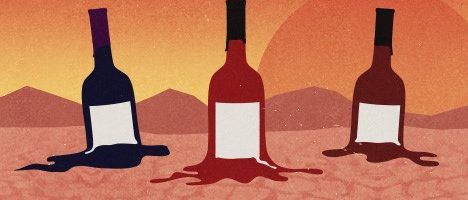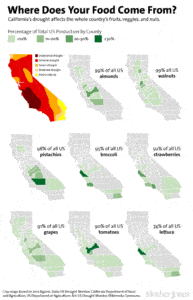Global Climate Change: Should we really be “wine”-ing?

Wat-er we thinking? As temperatures rise in conjunction with drought conditions, California wines are soaking up water reserves. Explore how one winery is fighting back and what more can be done!
The quality of wine is dependent upon the soil, temperature, and moisture level of the vineyard where the grapes are grown. Wine grapes are known to be highly sensitive to changing climatic conditions, though the various types of grapes have different requirements along those dimensions. The variation in climatic conditions from region to region is what enables us to experience a wide range in the types of wines produced around the world. [1] While these global differences are an asset to our wine selection set, we are now seeing both positive and negative implications of global climate change by region as rising temperatures have either enhanced or hindered grape growth.
In some of the cooler wine regions of the world, global climate change has resulted in earlier harvests and warmer temperatures without any drought conditions. Fortunately, in these regions these early harvests are associated with higher quality wine.[2] In California, however, rising temperatures have unfortunately coincided with drought conditions, thus creating challenges to produce quality grapes.[3] If temperatures continue to rise in joint with drought conditions, wineries in California will need to continue to increase their consumption of water to produce crops, or find other alternatives.
Farm production and food processing, including wine production, represent 80% of California water used for business and home. However, farm production and food processing generate only about 2% of California’s gross state product.[5] As drought conditions expect to continue with global climate change, California must think about its allocation of water to each of its agricultural products. Exhibit 1 highlights the diversity of the agricultural contributions California makes to the rest of the US, and the prevalence of those crops being grown in areas most affected by drought.
One California winery, E. & J. Gallo, has had a long history of sustainability and that tradition has served it well in adapting to rising temperatures and drought. Since the 1980s, Gallo has required an acre of open space for every acre of vineyard planted to preserve watershed and wildlife habitats.[6] More recently, Gallo has partnered with IBM to use big data to develop a more efficient irrigation system. Gallo has been collecting satellite data on its vineyards, and IBM created an irrigation system that translates that data into customized irrigation levels for small sections of vines. The initial trial of this new system resulted in a 26% improvement of crop yield and 25% reduction in water use.[7]
E. & J. Gallo has undoubtedly made great strides in their efforts to conserve water in the production of their wines, but, as global climate change continues, they and other California wineries may face more drastic alternatives to sustain their wine production. The first of these solutions is to change the grape varieties grown in the California vineyards. As temperatures rise, grapes that thrive in warmer climates, such as malbecs, become more appropriate alternatives to the traditional cabernet sauvignon grapes.[8] This option is a dramatic shift, as the California wines have become widely known for their unique flavors. Another alternative is to shift the vineyards to cooler regions, either in the mountains or closer to the coast to capture cooler air for the grapes to grow.[9]
Each of these alternatives are not necessarily ideal, but if rising temperatures and drought persists, the California wine industry may not be able to maintain its status quo without significantly increasing its water consumption. In the face of global climate change, should California’s scarce water resources be used to irrigate vineyards?
(Word Count: 788)
Cover Photo: “5 Things You Should Know About Global Warming And Wine”. Vivino. N.p., 2016. Web. 3 Nov. 2016.
[1] van Leeuwen, Cornelis and Philippe Darriet. “The Impact Of Climate Change On Viticulture And Wine Quality”. N.p., 2016. Web. 4 Nov. 2016.
[2] Jones, G. V., White, M. A., Cooper, O. R., & Storchmann, K. (2005). Climate change and global wine quality. Climatic Change, 73(3), 319-343. doi:http://dx.doi.org.ezp-prod1.hul.harvard.edu/10.1007/s10584-005-4704-2
[3] Cook, Benjamin I. and Elizabeth M. Wolkovich. “Climate Change Decouples Drought From Early Wine Grape Harvests In France”. N.p., 2016. Print.
[4] Park, Alex et al. “It Takes How Much Water To Grow An Almond?!”. Mother Jones. N.p., 2016. Web. 3 Nov. 2016.
[5] “Water Use In California (PPIC Publication)”. Ppic.org. N.p., 2016. Web. 2 Nov. 2016.
[6] “Responsibility | E. & J. Gallo Winery”. Gallo.com. N.p., 2016. Web. 2 Nov. 2016.
[7] Vanian, Jonathan. “How IBM Is Bringing Watson To Wine”. Fortune. N.p., 2016. Web. 3 Nov. 2016.
[8] Cooper, B. (2014, Dec 20). Sustainability in wine – part III: Dealing with drought in california. Just – Drinks Global News Retrieved from http://search.proquest.com.ezp-prod1.hul.harvard.edu/docview/1638573554?accountid=11311
[9] Handwerk, Brian. “New Vineyards Could Create Conservation Challenges”. National Geographic 2013. Web. 2 Nov. 2016.




First of all, terrific puns in your intro. Nothing makes a better blog post than a good pun. This post does an excellent job speaking about the effects climate change could have on potential crop yields, and what wineries can do to combat this, but what strikes me about wine in particular is how quality-driven the industry it is. I’d be interested in looking further into how the intensified weather effects of sporadic droughts, rising temperatures, or acidified rainfalls would impact the overall quality of particular wineries and the variability from year to year. While you pointed out some ways wineries can hedge, I’d think that some of the aspects that could impact quality could be very difficult to hedge.
Great perspective on how climate change and drought could truly change the wines we drink from California. The use of targeted irrigation is a great technological adaptation; however, I am curious what type of data the satellites are collecting? Is this data beyond normal historical weather data? Also how are they using this satellite data to their benefit?
Incredible post! As a heavy consumer of wine, I’m struggling with the future of the industry in the context of global warming. I wonder if climate change is just a threat for wine production, or if it can be an opportunity to develop new flavors and innovate in the variety of products. I think companies can apply your suggestions, creating value for consumers while addressing environmental problems.
What an interesting post! Given that California produces 90% of American wine, E. & J Gallo are clearly on to something that could become a huge issue. What I find particularly interesting is the connection to the length of the production cycle of wine. Wine is typically aged for several years so if any of these solutions are implemented, we may not see the effects on demand until much much later. And to that point, if we make a significant change to the way we produce wine and the demand effects are unfavorable, because of the large amount of time it takes to get a bottle of wine ready to consume, it makes it much more challenging to then reverse those changes or implement new ones.
Another interesting piece here is the variability within each region in California. I visited Napa this past summer and was amazed to see how the grapes and wines differ across the various regions, even though they are relatively close in distance. Some grapes can only be grown in certain parts of the Napa Valley, for example. As we think about changes and the idea of maybe moving vineyards to cooler regions, this could have major implications on the product mix that is produced in California. It also means that the water conservation strategies that work for one vineyard could have very different impacts to a vineyard that’s just a few miles away. Lots to think about here but the innovation is fascinating. Thanks for the post!
Very insightful & really enjoyed the post and topic. I just moved from SF/Sonoma Valley area which is full of these amazing wineries. I would be interested to see more on the breakdown of water usage across different crops as I always thought of almonds consuming a much higher proportion of overall water in the state of CA. I would also be curious to see how, like some other commenters suggested, the new irrigation system impacts the quality and taste of the wine. Here is some additional support over the effects of climate change on the wine industry, with a twist on the particular benefits Europe may see: http://www.npr.org/sections/thesalt/2016/03/21/470872883/an-upside-to-climate-change-better-french-wine. The article suggests, as you stated, that the global winemaking map may be re-drawn as wineries move to higher altitudes or latitudes as a response to climate change.
Cara, such an interesting and entertaining read on the future of California wines. I agree that more innovative irrigation techniques will need to be employed by Gallo and the like. I was honestly alarmed to hear that extreme droughts in California can and will have a huge impact on the grapes from that region. One interesting aspect I noted from Wolkovich and Cook in the NPR article “An Upside to Climate Change? Better French Wine” is that the effects of climate change are not equal across all regions. While temperatures are rising as a whole, certain areas in France could experience the perfect balance between climate-change-induced early harvests and the crippling droughts experienced in California. Seems like a fine line between producing premium wines and barely having sufficient water to produce at all. Excellent read!
Alastair Bland, “An Upside to Climate Change? Better French Wine,” March 21, 2016. http://www.npr.org/sections/thesalt/2016/03/21/470872883/an-upside-to-climate-change-better-french-wine
Cara, this is such an interesting post! I’m surprised that the government has not responded by regulating the industry’s water consumption better. As a fan of Californian wine, I would be concerned regarding the price of Californian wine going forward because sooner or later, water price has to increase in the region and producers will have no choice but to increase the price of wine. Should the price of water becomes to high to justify the production of wine, it’s interesting to see if the government will choose to subsidize the industry or not given the special nature of wine as a product.
Thanks so much for the post, Cara! And I agree with BAL, nothing like a good pun. “Farm production and food processing… represent 80% of California water used for business and home.” We hear lots about what we can do to conserve water during a drought. Quit watering lawns! Take a shorter shower! These small changes can certainly have a big impact, but not nearly on the scale that you’re describing. This is a very different issue, but it reminds me of other posts including one by Chaewon that brings up the huge impact of food (in her case, meat) production on the environment. I think if we are to promote sustainability we need to think carefully of where our food comes from and how its sourced.
Similar to a world without meat, many consumers hate thinking about a world without wine. Some might even argue that wine is an important part of cultures around the world. Where do we draw the line between enjoyment / culture and what is right for the environment. When are sacrifices too great? Is there another way? I’m reminded of the case we did on Indigo Agriculture — they have created plants that are drought resistant. Could they ever create drought-resistant grapes? Could this help?
Outstanding post, Cara. You raise concerning points about water use grape varietals in your post. I believe that wineries can cut costs by further utilizing technology (lab equipment and predictive computing) to optimize harvests by sugar and tannin content. In doing so, there will be less wasted harvest. Additionally, labor can be allocated at optimal times to reduce costs for wages and sub-optimal watering and treatment, as outlined in the following study: http://intrawww.ing.puc.cl/siding/datos/public_files/profes/smaturan_NBAIHYKHDFQXHNU/grapeharvest18.pdf